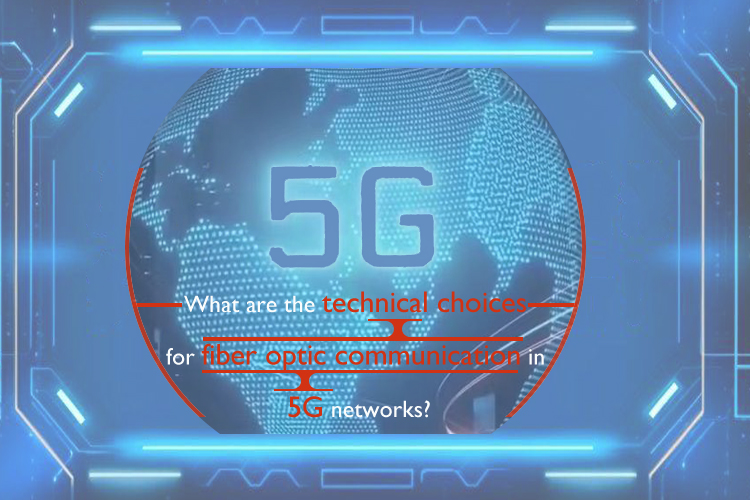Technical Choices for Fiber Optic Communication in 5G Networks
Introduction
With the advent of 5G networks, the demand for high-speed and reliable communication has skyrocketed. Fiber optic communication has emerged as a frontrunner in meeting these requirements due to its unmatched speed and capacity. However, when it comes to implementing fiber optic communication in 5G networks, several technical choices need to be considered. This article explores the two primary options: PON (Passive Optical Network) technology and point-to-point technology. We will delve into their benefits, drawbacks, and the factors to consider when making a choice.

PON Technology:
Enhancing Efficiency and Reducing Costs Passive Optical Network (PON) technology has been widely used in various network scenarios due to its ability to enable multiple users to access the same fiber optic cable, thus reducing costs. However, the existing PON specifications may not meet the high-speed requirements of 5G. Upgrades to the PON technology, such as XG-PON and NG-PON2, are being developed to cater to the increased demand for speed in 5G networks. These upgrades aim to enhance the downstream and upstream transmission rates, reducing latency and increasing bandwidth.
Point-to-Point Technology:
Ensuring Stability and High-Speed Point-to-point technology, also known as dedicated fiber connections, provides a dedicated optical link between two endpoints, ensuring more stable transmission and meeting the high-speed demands of 5G networks. Unlike PON, point-to-point technology does not share bandwidth among users, which minimizes latency and ensures consistent performance. However, deploying point-to-point connections on a large scale can be challenging due to higher costs associated with dedicated fibers and increased complexity in network management.
Factors Influencing the Choice of Technology When selecting the appropriate fiber optic communication technology for 5G networks, several factors come into play:
a. Network Scale: PON technology is well-suited for large-scale deployments as it allows multiple users to share the same fiber, reducing costs. Point-to-point technology, on the other hand, is more suitable for smaller-scale deployments where stability and high-speed are paramount.
b. Equipment Costs: PON technology offers cost advantages due to the sharing of fibers among multiple users. However, the upgrades required to meet 5G's high-speed demands may increase equipment costs. Point-to-point technology, although more expensive initially, may provide better long-term cost efficiency in certain scenarios.
c. Spectrum Utilization Efficiency: PON technology efficiently utilizes the available spectrum by sharing it among multiple users. Point-to-point technology, on the other hand, requires dedicated fibers, resulting in better utilization of the available spectrum but limited to a specific connection.
Conclusion
Choosing the right fiber optic communication technology for 5G networks is a critical decision that requires careful consideration. PON technology offers cost savings and scalability but needs upgrades to meet high-speed requirements. Point-to-point technology ensures stability and high-speed, but its deployment challenges and higher costs need to be considered. Ultimately, the choice depends on the specific needs of the network, equipment costs, scalability, and the desired level of service quality.
FAQs
Q1. Can PON technology meet the high-speed demands of 5G networks?
A1. While PON technology has proven effective in various network scenarios, the existing specifications may not meet the high-speed demands of 5G. Upgrades such as XG-PON and NG-PON2 are being developed to enhance its performance.
Q2. What are the advantages of point-to-point technology over PON?
A2. Point-to-point technology offers dedicated optical links, ensuring stable transmission and meeting the high-speed demands of 5G networks. It eliminates latency caused by shared bandwidth, providing consistent performance.
Q3. Is point-to-point technology suitable for large-scale deployments?
A3. Point-to-point technology can be challenging to deploy on a large scale due to higher costs associated with dedicated fibers and increased complexity in network management. It is more suitable for smaller-scale deployments.
Q4. Does PON technology offer cost advantages?
A4. Yes, PON technology allows multiple users to share the same fiber optic cable, reducing costs. However, the upgrades required to meet 5G's high-speed demands may increase equipment costs.
Q5. Which factors should be considered when choosing between PON and point-to-point technology?
A5. Factors such as network scale, equipment costs, and spectrum utilization efficiency should be considered. PON technology is suitable for large-scale deployments, while point-to-point technology offers stability and high-speed at the cost of increased complexity and higher expenses.
Keywords: fiber optic communication, 5G networks, PON technology, point-to-point technology, high speed, network scale, equipment costs, spectrum utilization efficiency.

 The Future of Fiber Optic Communication Network Architecture: Evolution and the Role of SDON Technology
The Future of Fiber Optic Communication Network Architecture: Evolution and the Role of SDON Technology
 What opportunities and challenges does free-space optical communication technology face?
What opportunities and challenges does free-space optical communication technology face?
 Opelink MPO Products for High-Speed Data Center Applications
Opelink MPO Products for High-Speed Data Center Applications
 CWDM vs. DWDM: Which Optical Transmission Technology Should You Choose?
CWDM vs. DWDM: Which Optical Transmission Technology Should You Choose?